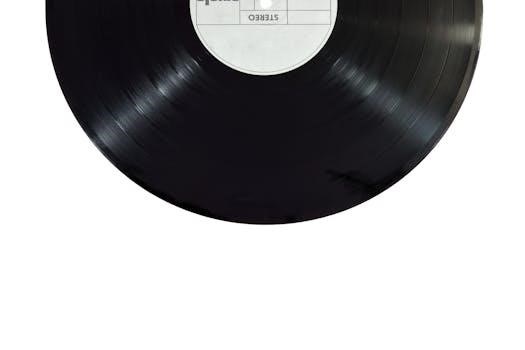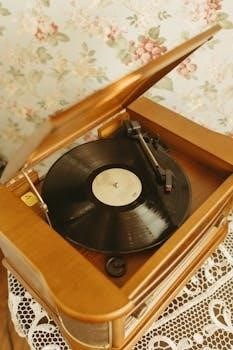Welcome to our comprehensive guide about turntable cartridges. We’ll explore what cartridges are, how they function, and the various types available. Selecting the right cartridge is key to maximizing your vinyl listening experience and achieving optimal sonic performance.
Cartridge Fundamentals
At its core, a turntable cartridge serves as the critical link between your vinyl record and your audio system. This electromechanical transducer transforms the intricate grooves of a record into an electrical signal, which is then amplified to produce the music you hear.
The cartridge houses a stylus, often made of diamond, that meticulously traces the record’s grooves. As the stylus vibrates, it generates movement within the cartridge’s internal components. This movement is then converted into a small electrical signal.
Understanding the fundamentals involves recognizing the cartridge’s role in accurately retrieving the information etched into the vinyl. Without a properly functioning cartridge, the nuances and details of your music could be lost. Therefore, appreciating how these devices function is essential for any vinyl enthusiast.
There are various cartridge types and designs, each with unique strengths and characteristics. Exploring these variations will enable you to make an informed decision when choosing a cartridge that aligns with your turntable, audio system, and personal preferences.
Types of Turntable Cartridges⁚ MM vs MC
Two primary types of turntable cartridges dominate the market⁚ Moving Magnet (MM) and Moving Coil (MC). The fundamental difference lies in how they convert the stylus’s physical movement into an electrical signal. Each type possesses distinct characteristics that influence sound quality, output level, and compatibility with phono preamplifiers.
MM cartridges, the more common and often more affordable option, feature a tiny magnet attached to the stylus cantilever. As the stylus traces the record’s grooves, the magnet vibrates within a set of stationary coils, inducing a voltage. MM cartridges typically have a higher output voltage, making them compatible with most standard phono preamps.

MC cartridges, on the other hand, employ a fixed magnet and a mobile coil. The coil moves within the magnetic field, generating an electromotive force. MC cartridges generally have lower output and often require dedicated MC phono preamplifiers or step-up transformers to boost the signal to a usable level.
Choosing between MM and MC cartridges depends on your budget, system configuration, and desired sound characteristics. Each type offers unique sonic qualities that cater to different listening preferences.
Moving Magnet (MM) Cartridges
Moving Magnet (MM) cartridges are the most prevalent type found in turntables, prized for their affordability, ease of use, and relatively high output signal. Their design centers around a tiny magnet attached to the end of the cantilever, which vibrates in response to the stylus tracing the record’s grooves. These vibrations induce a voltage within fixed coils, generating an electrical signal.
One of the key advantages of MM cartridges is their compatibility with a wide range of phono preamplifiers. Their higher output voltage allows them to work seamlessly with most standard phono stages, eliminating the need for specialized equipment.
MM cartridges are known for delivering a balanced and detailed sound, making them an excellent choice for both casual listeners and audiophiles. They offer a good level of sonic precision and clarity. Furthermore, MM cartridges generally have replaceable styli, extending their lifespan and reducing the overall cost of ownership.

Popular MM cartridge models include the Grado Prestige Black 3, Sumiko Rainier, and Audio-Technica AT-VM95E, each offering a unique sonic signature and price point to suit various preferences and budgets.
Moving Coil (MC) Cartridges
Moving Coil (MC) cartridges represent a higher tier of turntable technology, revered for their exceptional detail retrieval and nuanced sound reproduction. Unlike MM cartridges, MC designs feature tiny coils attached to the cantilever, moving within the magnetic field generated by fixed magnets. This configuration results in a significantly lower moving mass, allowing for quicker and more accurate tracking of record grooves.
However, MC cartridges also present unique challenges. Their extremely low output voltage necessitates the use of specialized phono preamplifiers with higher gain and impedance matching capabilities. This often translates to a higher initial investment.
MC cartridges are celebrated for their ability to extract subtle details and capture the full dynamic range of recordings. They offer a more refined and transparent sound compared to MM cartridges, making them a preferred choice for discerning audiophiles seeking the ultimate listening experience.
Examples include the Ortofon Quintet Blue, known for its agile sound and sonic precision, and the Vertere Sabre, a premium option offering explosive dynamics and impressive control. While often more expensive, MC cartridges provide a level of performance that justifies the cost for dedicated vinyl enthusiasts.
Cartridge Mount Types⁚ P-Mount vs Half-Inch Mount

Turntable cartridges come in two primary mounting styles⁚ P-Mount (also known as T4P) and Half-Inch Mount. Each offers a distinct approach to cartridge installation and compatibility.
P-Mount Cartridges⁚ P-Mount cartridges are designed for simplicity and ease of use. They feature a standardized plug-in connection with four terminals that directly interface with the tonearm. A single screw typically secures the cartridge, making installation straightforward and eliminating the need for precise alignment adjustments. P-Mount cartridges were prevalent on linear-tracking turntables and offer a convenient, plug-and-play solution.
Half-Inch Mount Cartridges⁚ Half-Inch Mount cartridges, on the other hand, provide greater flexibility and customization. They utilize two screws spaced half an inch apart for mounting. These cartridges feature four individual pins that connect to separate wires from the tonearm. This mounting style allows for fine-tuning of overhang, azimuth, and vertical tracking angle (VTA) to optimize performance.
Half-inch mounts are more common on higher-end turntables, appealing to audiophiles who desire precise control over cartridge alignment for superior sound reproduction; The choice depends on your turntable and desired level of adjustability.
Factors to Consider When Choosing a Cartridge
Selecting the right cartridge is a crucial step in optimizing your turntable’s performance. Several factors influence this decision, ensuring compatibility and achieving your desired sound quality.

Compatibility⁚ Verify that the cartridge type (MM or MC) is compatible with your turntable and phono preamp. Different cartridges require specific preamp settings to function correctly.
Budget⁚ Determine your budget range. Cartridge prices vary widely, and it’s essential to find one that offers the best value for your investment. As a general guideline, allocate roughly a quarter to a third of your turntable’s cost to the cartridge.
Turntable Specifications⁚ Consider your turntable’s tonearm mass and compliance. Matching these characteristics ensures optimal tracking and minimizes distortion.
Sound Preference⁚ Think about your preferred sonic characteristics. Some cartridges excel in detail retrieval, while others prioritize warmth or a balanced response. Consider what sounds best to your ears.
Stylus Shape⁚ Different stylus shapes (e.g., elliptical, conical, Shibata) offer varying levels of detail retrieval and tracking ability. Elliptical styli are a good balance of performance and cost.
Matching Cartridge Type to Turntable and System
Achieving optimal audio performance requires a synergistic relationship between your cartridge, turntable, and audio system. Matching the cartridge type to your specific setup is crucial for unlocking its full potential.
Moving Magnet (MM) Cartridges⁚ MM cartridges are generally more compatible with a wider range of turntables and phono preamps. Most turntables come equipped with built-in MM preamps, making them a convenient choice for beginners.
Moving Coil (MC) Cartridges⁚ MC cartridges often demand a more specialized setup. They typically require a dedicated MC phono preamp or a step-up transformer to boost their lower output signal to a usable level.
Gain and Loading⁚ Ensure that your phono preamp provides the appropriate gain and loading for your chosen cartridge. Improper gain can result in a weak or distorted signal, while incorrect loading can affect the cartridge’s frequency response.
Tonearm Mass⁚ Consider the tonearm mass of your turntable. High-compliance cartridges pair better with low-mass tonearms, while low-compliance cartridges are better suited for high-mass tonearms.
Importance of Vertical Tracking Force
Vertical Tracking Force (VTF) is the downward pressure exerted by the stylus on the record groove. Setting the correct VTF is vital for optimal sound quality and record preservation. Too little VTF can cause the stylus to mistrack, resulting in distorted audio and potential damage to your vinyl. Conversely, excessive VTF can lead to premature stylus wear and groove damage.
The recommended VTF range for your specific cartridge is usually specified by the manufacturer. Utilize a stylus force gauge to accurately measure and adjust the VTF. Begin by setting the VTF within the recommended range, and then fine-tune it by ear to achieve the best balance of sound quality and tracking ability.
Factors like record warp and tonearm resonance can influence the optimal VTF. Periodically check and adjust the VTF as needed. A properly set VTF ensures that the stylus maintains proper contact with the record groove, extracting the musical information accurately and minimizing wear.
Cartridge Materials and Construction
The materials and construction of a turntable cartridge significantly impact its performance and sound quality. Cartridge bodies are often made from materials like plastic, wood, or metal. Higher-end cartridges may use exotic hardwoods or even semi-precious materials like jade or marble to minimize resonance and improve rigidity.
The stylus, which makes contact with the record groove, is typically made of diamond. Stylus shapes vary, with elliptical and conical being the most common. Elliptical styli offer improved detail retrieval compared to conical styli. The cantilever, which supports the stylus, is usually made of aluminum, boron, or other lightweight materials. A stiffer cantilever improves tracking accuracy.
The internal components, such as the magnets and coils, also play a crucial role. High-quality materials and precise assembly contribute to a cartridge’s ability to accurately convert mechanical vibrations into an electrical signal. The overall construction should minimize unwanted vibrations and resonances, ensuring a clean and detailed sound.
Best Budget Cartridge Options
Upgrading your turntable cartridge doesn’t have to break the bank. Several excellent budget-friendly options offer significant improvements over stock cartridges. The Grado Prestige Black 3 is a popular choice, known for its elliptical diamond stylus and hand-assembled construction. It delivers audiophile-quality sound at an affordable price point. The Sumiko Rainier moving magnet cartridge offers excellent performance and ease of installation.
The Audio-Technica AT-VM95E is another highly regarded option, providing a balanced sound and good tracking ability. The Goldring E3 is also a great choice, offering clean and precise sound with plenty of clarity and power. The Ortofon OM 5E is a reliable option, offering good value for money and easy compatibility with various turntables.
When choosing a budget cartridge, consider the stylus shape, tracking force, and compatibility with your turntable and phono preamp. Reading reviews and comparing specifications can help you find the best option for your needs and budget.
Cartridge Brands Comparison
The turntable cartridge market features several prominent brands, each with its unique strengths and sonic characteristics. Ortofon, a Danish manufacturer, is renowned for its wide range of cartridges, from budget-friendly options to high-end models. Grado, an American company, hand-assembles its cartridges and is known for its warm and musical sound signature.
Audio-Technica offers a diverse selection of cartridges, catering to various budgets and preferences. Sumiko specializes in cartridges built in Japan and designs that are known for their thoughtful designs and ease of installation. Rega offers cartridges designed to match perfectly with their turntables, ensuring optimal performance and synergy.
Other notable brands include Nagaoka, known for its moving magnet cartridges, and Vertere, which produces premium cartridges with innovative designs. Ultimately, the best cartridge brand depends on your individual preferences, budget, and system setup. Researching and comparing the offerings from different brands will help you make an informed decision.
